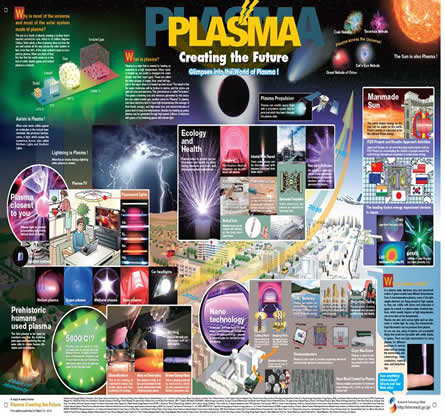What is a Plasma?
 A plasma is a partially or completely ionised gas containing electrons, ions, excited and ground state atoms and/or molecules, reactive free radicals and photons. Plasmas are common in the universe – they make up 90% of the observable cosmos. The sun and stars are huge clusters of high temperature plasmas. In the diffuse outer layers of the earth’s atmosphere, the ionosphere is a cool plasma. It was Langmuir in 1928 who introduced the term “plasma” and described it as a “fourth state of matter” alongside gases, liquids and solids.
A plasma is a partially or completely ionised gas containing electrons, ions, excited and ground state atoms and/or molecules, reactive free radicals and photons. Plasmas are common in the universe – they make up 90% of the observable cosmos. The sun and stars are huge clusters of high temperature plasmas. In the diffuse outer layers of the earth’s atmosphere, the ionosphere is a cool plasma. It was Langmuir in 1928 who introduced the term “plasma” and described it as a “fourth state of matter” alongside gases, liquids and solids.
We can create plasmas by subjecting a gas to an electrical field created by a high voltage alternating current, a d.c. discharge (continuous or pulsed), a microwave or radio frequency field. In the field, the electrons are stripped from some or all of the gas atoms or molecules and gain energy. These energetic electrons then collide with the atoms and molecules in the gas creating further ions and excited states. They can also cause molecules to break apart forming reactive fragments or free radicals but not all the molecules are dissociated. The study of gas discharges began in the early nineteenth century with work by Sir Humphry Davy in 1808 on the d.c. arc discharge followed by further developments by Michael Faraday in the 1830’s. In 1839, Sir William Crookes was the first to produce and recognise plasma by heating a solid to very high temperatures, melting it, vaporising it to a gas and then breaking the gas into electrons and ions.
We can classify plasmas according to their pressure of operation; low pressure or atmospheric pressure. In addition, they can also be described by their degree of equilibrium. If all the species in the plasma are in equilibrium and can be described by a single temperature, this is a thermal plasma. However, if there is a high degree of disequilibrium in the plasma where the electrons have a very high energy (or a temperature of tens of thousands of degrees Kelvin), the ions are somewhat less energetic and the residual gas atoms and molecules are still close to room temperature, we have a non-thermal or low-temperature plasma. In general, non-thermal plasmas operate at low pressures and thermal plasmas at high pressures. However, much current research centres on the application of non-thermal, atmospheric pressure plasmas.
What can plasmas be used for?
A plasma contains a soup of highly reactive radicals, atoms, molecules, electrons and ions created by the discharge. It can be used to modify surfaces (e.g. etching of semiconductors to make microelectronic devices, nitriding of steel to make hardened tools, changing the properties of materials such as plastics and fabrics to make them stick together better or to resist water) or to deposit material onto surfaces (e.g. growing artificial diamond films or placing protective coatings onto spectacles).
The excited atoms or molecules in the plasma will decay by giving out photons and this can be used to produce lamps for lighting or for the UV sterilisation of water.
Non-thermal, atmospheric pressure plasmas can be used to destroy pollutants in waste gas streams. These can be soot and NOx from diesel engine exhausts, volatile organic compounds emitted from processing plants or “smelly” molecules from landfill sites, animal houses or food processing.
Further Reading
Bill Graham “Technological Plasmas” in Physics World, March 2001 (Volume 14, Issue 3, p 31)
R. McAdams “Prospects for non-thermal atmospheric plasmas for pollution abatement”, J.Physics D., Applied Physics, 34 (2001) 2810-2821.
